The Fish Hydrolysate Market is estimated to be valued at USD 534.8 million in 2025 and is projected to reach USD 784.0 million by 2035, registering a compound annual growth rate (CAGR) of 3.9% over the forecast period.
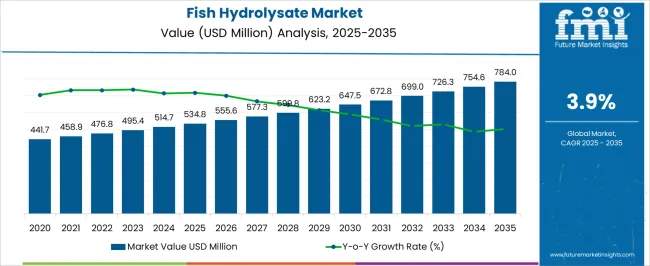
| Metric | Value |
|---|---|
| Fish Hydrolysate Market Estimated Value in (2025 E) | USD 534.8 million |
| Fish Hydrolysate Market Forecast Value in (2035 F) | USD 784.0 million |
| Forecast CAGR (2025 to 2035) | 3.9% |
The Fish Hydrolysate market is experiencing steady growth driven by increasing demand for sustainable protein sources, functional ingredients, and eco-friendly nutritional supplements. The current market landscape reflects a strong focus on health-conscious and environmentally responsible food production.
Growth is being supported by rising awareness of the nutritional benefits of fish-derived proteins, including essential amino acids, peptides, and micronutrients, which are widely used in food and feed industries. The expansion of aquaculture and sustainable fisheries, coupled with regulatory encouragement for natural and organic ingredients, is shaping the future trajectory of this market.
Additionally, innovations in processing technologies, such as enzymatic hydrolysis, have improved product stability, functionality, and flavor profiles, making Fish Hydrolysate more suitable for a wide range of applications As global food production shifts toward high-value proteins and functional nutrition, opportunities are expected in both food ingredient sectors and animal feed formulations, positioning Fish Hydrolysate as a versatile, high-demand product with long-term growth potential.
The fish hydrolysate market is segmented by form, application, distribution channel, and geographic regions. By form, fish hydrolysate market is divided into Liquid and Powder. In terms of application, fish hydrolysate market is classified into Food Industries, Pharmaceuticals, Feed Industries, Agriculture, and Others. Based on distribution channel, fish hydrolysate market is segmented into Indirect and Direct. Regionally, the fish hydrolysate industry is classified into North America, Latin America, Western Europe, Eastern Europe, Balkan & Baltic Countries, Russia & Belarus, Central Asia, East Asia, South Asia & Pacific, and the Middle East & Africa.
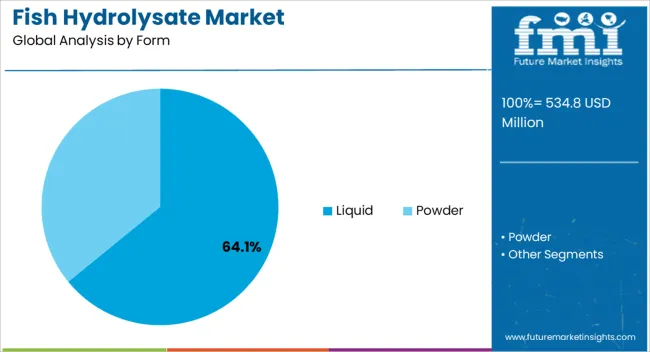
The liquid form segment is projected to hold 64.10% of the Fish Hydrolysate market revenue share in 2025, making it the leading form type. This dominance is being driven by its versatility, ease of integration into various food and feed formulations, and consistent bioavailability of nutrients. Liquid hydrolysates allow efficient mixing in feed and food production processes, reducing handling and preparation time while maintaining nutritional integrity.
Adoption has been accelerated by the growing need for soluble, highly digestible protein sources in both human and animal nutrition. The ability to blend liquid hydrolysates with other functional ingredients without loss of quality has made this form highly preferred.
Additionally, liquid formulations facilitate scalable industrial production and support cost-effective supply chains, contributing to wider market penetration The rising demand for natural protein ingredients in food industries, combined with the advantages of liquid processing, ensures continued growth of this segment in the coming years.
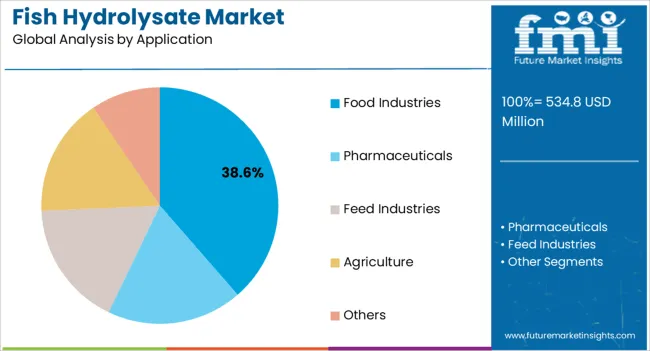
The food industries application segment is expected to account for 38.60% of the Fish Hydrolysate market revenue share in 2025, establishing it as the dominant application area. Growth is being supported by the increasing use of Fish Hydrolysate in functional foods, dietary supplements, and nutraceutical products, where its high protein content and bioactive properties enhance nutritional value.
Adoption has been further reinforced by consumer trends favoring natural, sustainable, and minimally processed ingredients. The versatility of Fish Hydrolysate in flavor-neutral formulations allows manufacturers to incorporate it into a wide range of products, from beverages to protein-rich snacks.
Processing improvements that preserve bioactive compounds have increased its effectiveness, while regulatory encouragement for natural protein enrichment has boosted commercial adoption As demand for functional nutrition and health-focused food products continues to rise, the food industries segment is expected to maintain its leadership, driven by innovation, sustainability, and cost-efficiency in production.
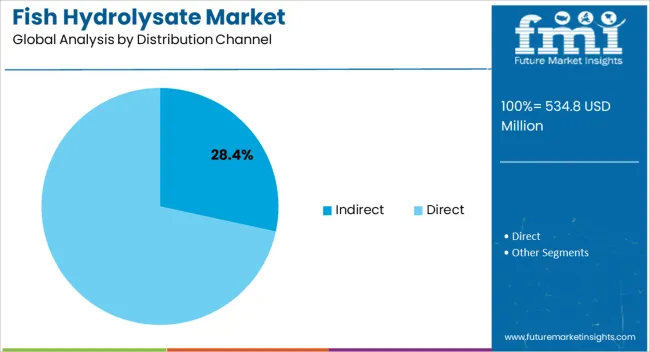
The indirect distribution channel segment is anticipated to hold 28.40% of the Fish Hydrolysate market revenue share in 2025, making it the leading distribution method. This segment’s growth has been fueled by the reliance of manufacturers on distributors, wholesalers, and brokers to reach diverse end users across food and feed industries.
Indirect channels provide advantages such as wider geographic coverage, reduced logistical complexity, and access to specialized market segments. Adoption has been reinforced by the need for streamlined procurement processes, inventory management, and supply chain efficiency, which allow producers to focus on manufacturing and product development.
Additionally, distributors often provide technical support, market intelligence, and regulatory compliance assistance, enhancing their value in the supply chain As the Fish Hydrolysate market expands globally and end-use industries demand consistent supply and quality assurance, the indirect distribution channel is expected to maintain its prominence, ensuring efficient delivery and supporting sustainable market growth.
This upward trend can be attributed to several key forces shaping the fish hydrolysate sector. Fish hydrolysates are low in chemicals and high in nutrients. They help improve the animals' metabolism and overall health. This is what is driving the market. As public knowledge of the risks associated with chemical fertilizers has increased, there has been a shift in the use of non-chemical products.
Fish hydrolysates are becoming more and more in demand as a safe and nutritious substitute for animal feed because they do not contain any chemicals. Furthermore, there is a lot of collagen in fish hydrolysates.
It is also used as gelatin in the food industry for both flavored and unflavored culinary goods. Because of its high collagen concentration, it is also used in the pharmaceutical industry to help people consume more protein and to offer anti-aging advantages.
The increasing consumer knowledge of the health advantages of fish protein is one of the main factors. Foods high in vital nutrients are what consumers are looking for more and more, and fish hydrolysate is a great option in this respect.
With an abundance of amino acids and bioactive peptides that support general health and well-being, it has a high nutritional profile. Customers are seeking out food and beverage items that include fish hydrolysate as a result of this increased knowledge, which is driving the industry forward.
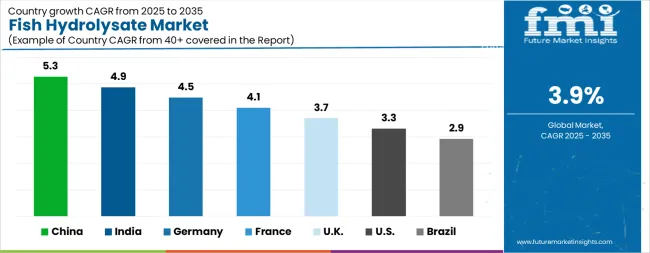
| Country | CAGR |
|---|---|
| China | 5.3% |
| India | 4.9% |
| Germany | 4.5% |
| France | 4.1% |
| UK | 3.7% |
| USA | 3.3% |
| Brazil | 2.9% |
The Fish Hydrolysate Market is expected to register a CAGR of 3.9% during the forecast period, exhibiting varied country level momentum. China leads with the highest CAGR of 5.3%, followed by India at 4.9%. Developed markets such as Germany, France, and the UK continue to expand steadily, while the USA is likely to grow at consistent rates. Brazil posts the lowest CAGR at 2.9%, yet still underscores a broadly positive trajectory for the global Fish Hydrolysate Market. In 2024, Germany held a dominant revenue in the Western Europe market and is expected to grow with a CAGR of 4.5%. The USA Fish Hydrolysate Market is estimated to be valued at USD 191.6 million in 2025 and is anticipated to reach a valuation of USD 265.5 million by 2035. Sales are projected to rise at a CAGR of 3.3% over the forecast period between 2025 and 2035. While Japan and South Korea markets are estimated to be valued at USD 26.0 million and USD 16.1 million respectively in 2025.
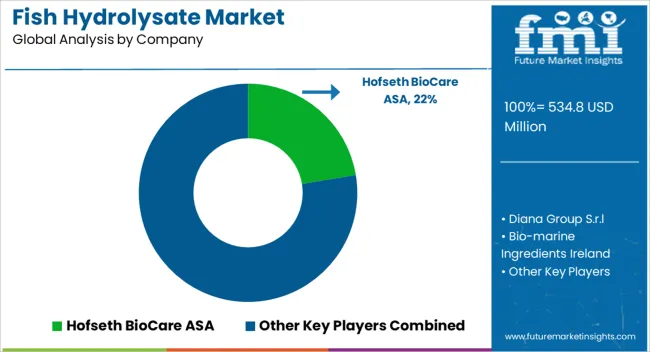
| Item | Value |
|---|---|
| Quantitative Units | USD 534.8 Million |
| Form | Liquid and Powder |
| Application | Food Industries, Pharmaceuticals, Feed Industries, Agriculture, and Others |
| Distribution Channel | Indirect and Direct |
| Regions Covered | North America, Europe, Asia-Pacific, Latin America, Middle East & Africa |
| Country Covered | United States, Canada, Germany, France, United Kingdom, China, Japan, India, Brazil, South Africa |
| Key Companies Profiled | Hofseth BioCare ASA, Diana Group S.r.l, Bio-marine Ingredients Ireland, Copalis, Janatha Fish Meal & Oil Products, Scanbio Marine Group AS, Sopropêche, Omega Protein Corporation, Sociedad Pesquera Landes Sa, TC Union Agrotech, and United Fisheries |
The global fish hydrolysate market is estimated to be valued at USD 534.8 million in 2025.
The market size for the fish hydrolysate market is projected to reach USD 784.0 million by 2035.
The fish hydrolysate market is expected to grow at a 3.9% CAGR between 2025 and 2035.
The key product types in fish hydrolysate market are liquid and powder.
In terms of application, food industries segment to command 38.6% share in the fish hydrolysate market in 2025.






Our Research Products

The "Full Research Suite" delivers actionable market intel, deep dives on markets or technologies, so clients act faster, cut risk, and unlock growth.

The Leaderboard benchmarks and ranks top vendors, classifying them as Established Leaders, Leading Challengers, or Disruptors & Challengers.

Locates where complements amplify value and substitutes erode it, forecasting net impact by horizon

We deliver granular, decision-grade intel: market sizing, 5-year forecasts, pricing, adoption, usage, revenue, and operational KPIs—plus competitor tracking, regulation, and value chains—across 60 countries broadly.

Spot the shifts before they hit your P&L. We track inflection points, adoption curves, pricing moves, and ecosystem plays to show where demand is heading, why it is changing, and what to do next across high-growth markets and disruptive tech

Real-time reads of user behavior. We track shifting priorities, perceptions of today’s and next-gen services, and provider experience, then pace how fast tech moves from trial to adoption, blending buyer, consumer, and channel inputs with social signals (#WhySwitch, #UX).

Partner with our analyst team to build a custom report designed around your business priorities. From analysing market trends to assessing competitors or crafting bespoke datasets, we tailor insights to your needs.
Supplier Intelligence
Discovery & Profiling
Capacity & Footprint
Performance & Risk
Compliance & Governance
Commercial Readiness
Who Supplies Whom
Scorecards & Shortlists
Playbooks & Docs
Category Intelligence
Definition & Scope
Demand & Use Cases
Cost Drivers
Market Structure
Supply Chain Map
Trade & Policy
Operating Norms
Deliverables
Buyer Intelligence
Account Basics
Spend & Scope
Procurement Model
Vendor Requirements
Terms & Policies
Entry Strategy
Pain Points & Triggers
Outputs
Pricing Analysis
Benchmarks
Trends
Should-Cost
Indexation
Landed Cost
Commercial Terms
Deliverables
Brand Analysis
Positioning & Value Prop
Share & Presence
Customer Evidence
Go-to-Market
Digital & Reputation
Compliance & Trust
KPIs & Gaps
Outputs
Full Research Suite comprises of:
Market outlook & trends analysis
Interviews & case studies
Strategic recommendations
Vendor profiles & capabilities analysis
5-year forecasts
8 regions and 60+ country-level data splits
Market segment data splits
12 months of continuous data updates
DELIVERED AS:
PDF EXCEL ONLINE
Fish Protein Hydrolysate Market Size and Share Forecast Outlook 2025 to 2035
Fish Protein Hydrolysate For Animal Feed And Pet Food Applications Market Size and Share Forecast Outlook 2025 to 2035
Fish Pond Circulating Water Pump Filter Market Size and Share Forecast Outlook 2025 to 2035
Fish Protein Isolates Market Size and Share Forecast Outlook 2025 to 2035
Fish Meal Alternative Market Size and Share Forecast Outlook 2025 to 2035
Fish Oil Alternatives Market Size and Share Forecast Outlook 2025 to 2035
Fish Protein Concentrate Market Size and Share Forecast Outlook 2025 to 2035
Fish Feed Pellet Making Machine Market Size and Share Forecast Outlook 2025 to 2035
Fish Fermentation Market Size and Share Forecast Outlook 2025 to 2035
Fishing Reels Market Analysis - Size, Share, and Forecast Outlook 2025 to 2035
Fish Filleting Machine Market Size and Share Forecast Outlook 2025 to 2035
Fish Deboning Machine Market Size and Share Forecast Outlook 2025 to 2035
Fish Cutting Machine Market Size and Share Forecast Outlook 2025 to 2035
Fish Processing Equipment Market Size and Share Forecast Outlook 2025 to 2035
Fishmeal and Fish Oil Market Analysis - Size, Share, and Forecast Outlook 2025 to 2035
Fish Feed Ingredients Market Analysis - Size, Share, and Forecast Outlook 2025 to 2035
Fish Collagen Market Analysis - Size, Share, and Forecast Outlook 2025 to 2035
Fish Bone Minerals Market Analysis - Size, Share, and Forecast Outlook 2025 to 2035
Fish Peptones Market Size, Growth, and Forecast for 2025 to 2035
Fish Nutrition Market Size, Growth, and Forecast for 2025 to 2035

Thank you!
You will receive an email from our Business Development Manager. Please be sure to check your SPAM/JUNK folder too.
Chat With
MaRIA